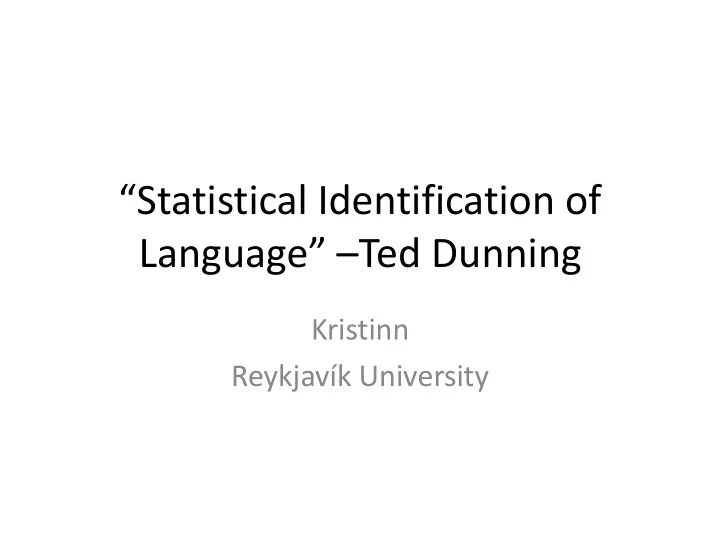

“Statistical Identification of Language” – Ted Dunning Kristinn Reykjavík University
Languages • 안녕하세요 • Halló • Hello • こんにちは • Hallo • 你好 • Hola • 你好 • Bonjour 2
Languages • Halló • 안녕하세요 – Íslenska • Korean • Hello • こんにちは – English • Hallo – Japanese – German • 你好 • Hola – Chinese (traditional) – Spanish • Bonjour • 你好 – French – Chinese (simplified) 3
Introduction • Statistical based program has been written which learns to distinguish between languages, e.g. Spanish, English, French – 100 words of code – Only needs a few thousand words of sample text in order to learn the language – Works very well with 92%+ accuracy and more accurate with a larger “learning text”. – Learning text implies a sample of text which the computer program can “tokenize” 4
Bayesian Method with Markov Probablity • Bayesian logic probablity, i.e. deciding which event is causing the observation by observing • Markov probability is analyzing past events to predict future events, i.e. weather systems. 5
Previous Work: Unique Letter Combinations • Enumerating a number of short sequences from text which are unique to a particular language • Drawback: Languages sometimes adobt words from other cultures, e.g. Geography, Movies, Names, etc.. 6
Previous Work: Common Words • Devise a list of commonly used words in a language. – English: the, of, to, and, a, in, is, it, you, “etc..” – German: der/die/das, und, sein, in, ein, zu, “etc..” – Spanish: el/la, de, que, y, a, en, un, ser, se, “etc..” • Drawback: not all langauge phrases contain these words. Difficult to tokenize a language such as Chinese and therefore impossible to implement this method. 7
Previous Work: N-gram counting with rank order • Ad hoc rank ordering of tokenized text. Or, comparing tokenized text to a large library of text from a source such as network news groups. • Drawback: Input had to be tokenized and the statistical rank order of text was dependant on longer text sizes, i.e. 4K or 700 words 8
Markov Method • The Markov model defines a random variables whose values are strings from an alphabet X, and where the probability of a particular string S is: • We are loooking at the sequence of characters in a learning text, but not considering language structure. 9
Bayesian Method • If we are choosing between A and B given an observation X, where we feel that we know how A or B might affect the distribution of X, we can use Bayes’ theorem. • looking for what happened before this current character. What is most porbable since this event already occured. 10
Summarised • This method reads from a learning text of a relatively small size. – Test results • Language: English and Spanish • Learning text: 10 training texts of size: 1000, 2000, 5000, 10,000, and 50,000 bytes length • Tests Texts: 100 different tests: 10, 20, 50, 100, and 500 bytes in length 11
Test Results 12
Why and Where? • Genetic sequence analyzers – Determining the species which a particular animal or plant, etc.. • Determining the origin of a language. – http://whatlanguageisthis.com/ 13
Questions 14
Recommend
More recommend